Feudal Russia and modernization of the XNUMXth century
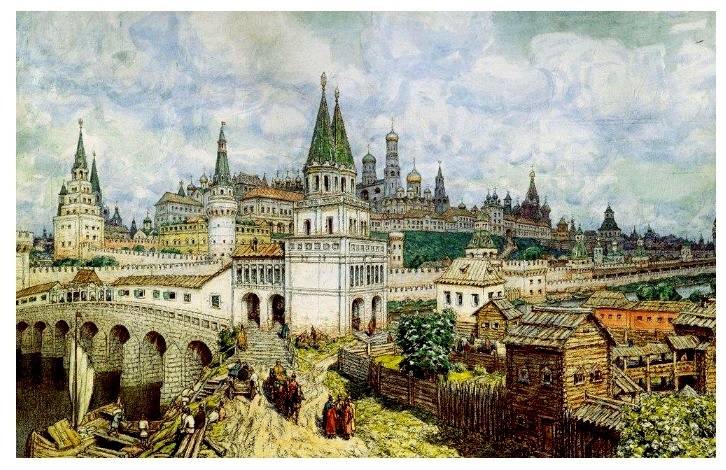
Vsekhvyatsky bridge and the Kremlin at the end of the XNUMXth century. Hood. A. Vasnetsov. XNUMXth century
In the two previous articles, I described the interrelated situation associated with the external military factor and the formation of Russian feudalism, the emergence of a class of feudal lords and peasants. But another, important factor that determined the specifics of the development of Russian feudalism was not covered in these articles.
Russia in the XNUMXth century reforms, or what is traditionally called modernization, were on the agenda. These transformations had to be carried out in a society that had just taken shape as a feudal one. Where "enslavement" marked the creation of feudalism and the feudal state at a time when many European states were at the stage of transition to capitalism. Therefore, we observe a significant difference in the development of technology and the economy.
Slavic patriot Yuri Krizhanich spoke in detail about the economic situation in the country, considering it to be a "lag".
I have already written more than once that this was not quite a lag. This lag was only in comparison with the leading European West. Russia in the XNUMXth century perfectly corresponded to that stage of social development, which is called feudalism. Of course, not without adjusting for the zone of risky agriculture in which the country was located, or stepmother nature.
Here are its key features: the weak development of local trade and the virtual absence of international trade. Raw materials are exported out of need, and not because of surpluses (wheat, rye, leather, wax, caviar). Due to the weak development of finance, foreign merchants occupied a dominant position in trade. There is no mining of ores, the craft and the basis of the country - agriculture - were at an extremely low productive level. And all this in a country with a huge and uninhabited territory, writes Krizhanich, which is under constant threat from nomads.
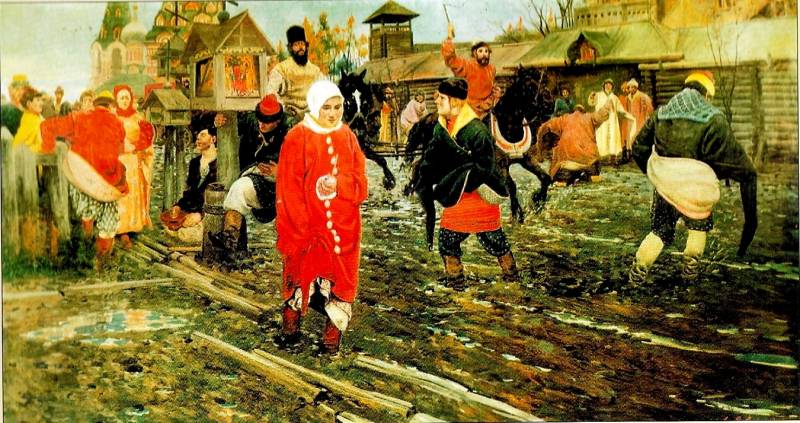
Moscow street XVII century. Hood. A. Ryabushin. XIX century
And the almost complete absence of modern technology, primarily military. And just as technologies had nowhere to come from in early feudal Europe, so in Russia at the beginning of the XNUMXth century no forces could create them, the social structure of society was not yet ready for this.
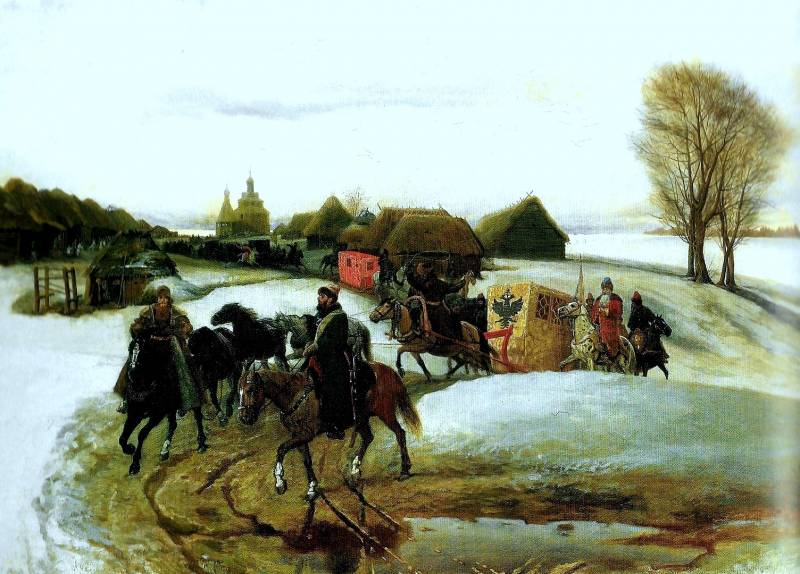
Spring train of the queen on a pilgrimage under Tsar Alexei Mikhailovich. Hood. V. Schwartz of the XNUMXth century
And there was only one way: to borrow. The borrowing of more advanced technologies, primarily in military affairs, began under Ivan III, and they never stopped. What is traditionally called in historiography and journalism "modernization" in the XNUMXth century was in fact "total borrowing".
There was nothing special to modernize, in Russia there was not a single “factory” or “factory”, more precisely, a manufactory, there were no maps, no paper, no cannonballs, no swords, no fabrics for army clothes. Neither scientists, nor science, nor just secular education, even the level of knowledge of the priests was extremely low and limited to the scholastic performance of rituals, etc., etc. The same situation is in the key economic sector of Russia - agriculture, built on the principles of natural management economy.
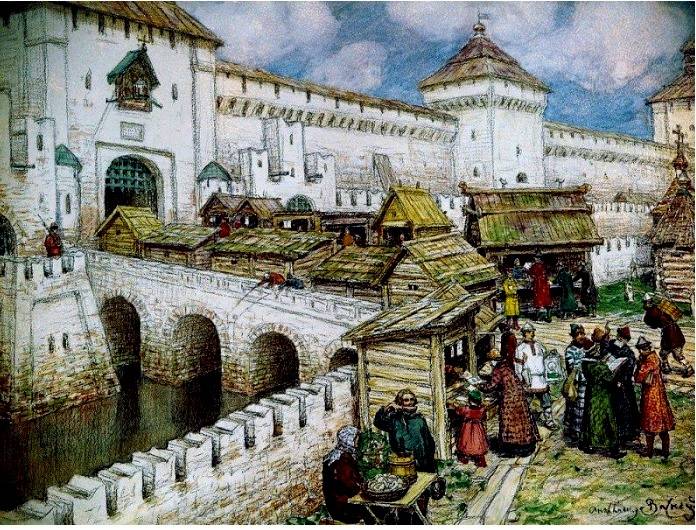
Bookshop on the Spassky bridge in Moscow. Hood. A. Vasnetsov. XNUMXth century
It is important to understand what we have already written about, there were no algorithms for making changes, it was an intuitive way. At the same time, the state had to solve a huge number of tasks.
What can we say about borrowing in the field of armaments, when the Lithuanian Statute of 1649, written in Russian language, was used as a model and plan for the design of the first feudal legislation, the Council Code of 1588.
"Gunpowder revolution" and "total borrowing"
The “Military Revolution” or the “Great Gunpowder Revolution”, which we already wrote about, in Western Europe at the turn of the end of the Middle Ages and the beginning of the New Age led to an integrated approach to managing the army and conducting combat operations, where the main character was a soldier who implicitly follows orders and armed with a gun weapons. This situation on the battlefield would last almost unchanged until the French Revolution.
The "military revolution", according to a number of researchers, led to the military superiority of the countries where it took place, which was demonstrated even by peripheral Sweden, which captured almost the entire coast of the Baltic Sea and smashed the imperial troops in Germany during the 30-year war of 1618-1648.
Therefore, the first Russian tsars from the Romanov family and their entourage, simultaneously with the formation of the state, had to solve the issue of technological total borrowing.
The system of the feudal militia, which had just been formed with such difficulty in a natural way, no longer met the requirements of modern warfare:
The factor of discrepancy between the social structure of society and technological borrowings will become decisive in the development of the country from this period.
This gave rise to talk about Russia as a country with a "catch-up type of development."
Once again about Russian feudalism
The need for technology and pressure from technologically more developed countries significantly influenced and gave specific features to the development of feudalism in Russia. That is why we do not see a number of European feudal institutions in Russia, since its genesis took place in other material conditions.
The European knight was formed in battle conditions using exclusively edged weapons, fought, in fact, alone, which imposed a certain style of behavior on the feudal lords and formed a knightly ethics, mentality, with all the ensuing consequences. While the formation of the "Russian knight" took place in the conditions of a firearms battle, when the clash of disciplined soldiers replaced individual skill and duel. By the middle of the 1632th century, the noble militia was completely armed with firearms, but did not have new military knowledge and skills. So the confrontation between the local militia and the regiments of the foreign or new system did not make it possible to take Smolensk in 1634–XNUMX.

Boyar Hood. P. Chistyakov. nineteenth century
The most important factor in mastering new military technologies, by which we mean primarily the control and combat system caused by the “gunpowder revolution”, was the presence of hired foreign specialists who led and trained new units. Even in the defense of Albazin on the Amur from the troops of Qing China in 1686, the Cossack head, the German A. Beiton, participated. And the level of understanding of military technologies was described in his diary by the Scottish mercenary Patrick Gordon, the future associate of Peter I. Boyar I.D. Miloslavsky tested foreign officers not for knowledge and ability to manage units, but for “exercise” with spears and muskets.
Ambassador Meyerberg counted in Moscow in 1662 one hundred colonels, even more lieutenant colonels and majors, countless captains and ensigns, there were two full generals and two major generals from Germany, Holland, England and especially from Scotland. The share of Russian commanders in the infantry and reytar regiments was 23%.
Initially, the creation of new units, for example soldiers, took place on a temporary basis, and the quality of the soldiers was inferior to the same archers. Dragoons were also temporarily recruited in the Komarin and Voronezh regions, Lebedyansky district. Throughout the XNUMXth century, along with the old system of formation of the armed forces at the expense of acting jointly noble "cities" (hundredth system), uniform Reiter regiments were being formed, where "city Cossacks" and low-income nobles were recruited; regiments of heavy hussar cavalry are created according to Polish models.
But all these changes occur with great difficulty, which is noted by all historians-specialists in military development and the army of the XNUMXth century. The regiments of the new system could only be maintained in wartime, while the local cavalry, relatively speaking, is on self-sufficiency.
Manufactory and technology
Borrowings were urgently needed in the field of "industrial" production. They began with the hiring of a huge number of different specialists in all sorts of specialties that are not available in Russia. And, of course, for the production of weapons and their components. An attempt to expand iron production at extremely primitive hand-made factories in the 20s. did not bring success. With an extreme shortage of funds, the purchase of high-quality iron and items from it was made abroad at an inflated price. So, in Sweden, the merchant K. Demoulin purchased cannons for 17 thousand rubles, in 1629 the cannonballs were bought at a price of 60 kopecks. for the core. Swords, muskets, and other weapons were bought in Sweden, England and Holland.

Gun. Syul. Thuringia. 1660s GIM. Moscow. Russia. Photo of the author.
Therefore, the government went on full borrowing in this area, allowing three foreign merchants in 1632 to build water-operating manufactories, completely, in modern terms, on foreign technologies, where water energy was used instead of hand bellows: water-operating hammers and a high blast furnace.
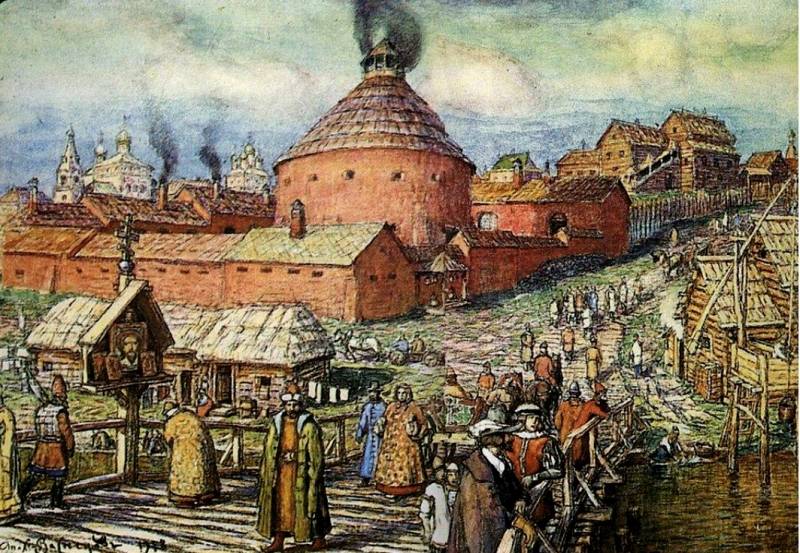
Cannon yard on Neglinnaya. Hood. A. Vasnetsov
In Europe, from where they were borrowed, they arose naturally from small-scale production. Manufactories were built first by the Dutchmen Andreas Vinius and Peter Marselis in Tula, and then near Moscow, in Kashira and Borovsk. That is, in the area of high-quality iron ore mining. The Urals has not yet been explored for the presence of ores. Since the 80s, ironworks have been created in the Olonets region. In total, 12 such plants were built by foreigners. In the 20s. and the archaic Cannon Yard in Moscow, with the help of foreign craftsmen, was converted into a water-working plant.
Most of the workers in these factories, even in the 90s, were foreigners. All enterprises worked for the treasury, more precisely - for the military department: during this time, by the 80s. prices for a pood of cannon iron fell from 70 to 30 kopecks, for a core - from 40 to 20 kopecks, only plank iron for carbines rose in price. Production expanded so much that a small export of cannons began already in the 40s of the XNUMXth century.
We observe the same situation in all other sectors of the economy, borrowings go everywhere. It is significant that if in Europe a spinning wheel with a wheel, which many still found with their grandmothers in the XNUMXth century, began to take root in the XNUMXth-XNUMXth centuries, then in Russia the change of a spinning wheel with a spindle to a spinning wheel with a wheel only began at the end of the XNUMXth century with the help of hired Polish artisans.
The Dutch create a number of industries built on "modern" technologies that are not available to Russian artisans: leather, glass and potash, they built a rope manufactory. With the help of gardeners from the “Germans”, proper gardening was created and “pharmaceutical gardens” were planted.
Among the highest dignitaries there was an understanding that "technologies" were based on knowledge and required the creation of schools and the study of languages. Thus, F. M. Rtishchev (1626–1673), the favorite of the tsar, personally created a secular school with the help of monks from Kyiv.
Along with Western technology came fashion, all sorts of household material amenities that were not even in the palace. Their admirers were also the uncle of the tsar, an ambiguous personality, the head of the country under the young tsar Alexei and the patron of foreign merchants, B.I. Morozov (1591–1661) and his associate, who visited Holland, the steward I.D. favorite of Empress Sophia, Prince V.V. Golitsyn (1595–1662), who had “the most European palace” in Europe.
The finances of the feudal country
But the borrowing of technology, the maintenance of the army and the construction of defense structures required huge resources. It is significant that in Russia-Russia the beginning of feudalism, the general budget did not exist, and each order was engaged in its own financing and distribution of expenses, lending to needy orders.
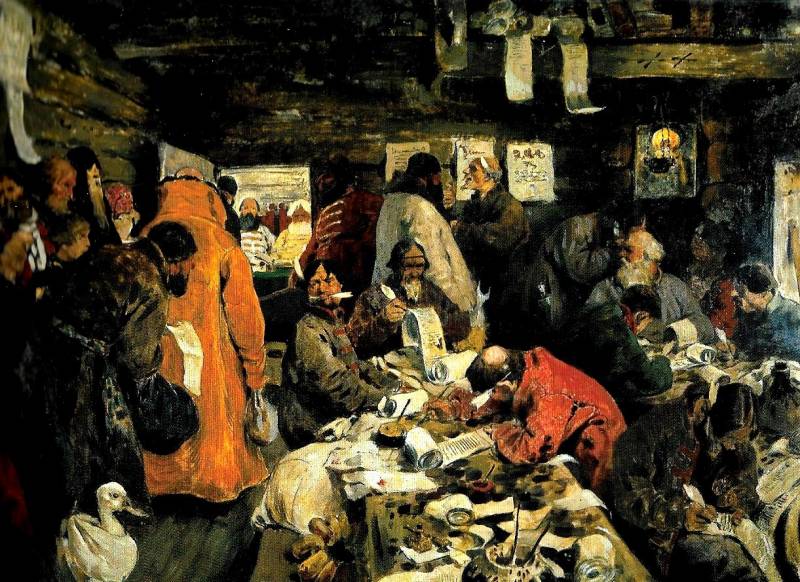
In the order of the Moscow time. Hood. S. Ivanov. XNUMXth century
In addition to everything, Russia simply did not have its own money, that is, of course, there was a name, and there were exchange units, but there was no issue. Due to the lack of silver, the government bought silver (Russian "efimki", thalers) abroad and interrupted the coins. It was because of this that during the Polish war the government was forced to introduce copper money into circulation. Which was completely logical and justified, but the self-interest of the highest dignitaries led to their depreciation. This, in turn, caused the copper riot of 1662. It is obvious that the same situation directly affected the country's trade turnover, when, due to the lack of domestic emission, merchants turned into agents of foreign merchants who had silver money, "dollars" of that period. .
This dependence contributed to the periodic issuance of monopolies to foreign merchants (the British), which were extremely painful for the Russians. The policy of mercantilism of European countries was a painful blow to Russian trade. It happened that in the conditions of an urgent need for money, the government appointed a double duty on foreign goods, I recommend that they compensate for everything at the expense of Russian merchants.
What is the outcome?
It is a well-known fact that these technological borrowings did not work. True, there is an opinion that they were the forerunner of the "modernization" of Peter I, without which it would not have been possible. There are several reasons why this borrowing was not completed, and they are interconnected.
Firstly, it took place in the conditions of early feudalism, with the corresponding mental representations, where in a Christian society borrowing could lead to the loss of the soul, as in the case of tobacco, when it was allowed and then banned.
Secondly, in the period when both the management system and taxation were just being built, hence the leapfrog in units or objects of taxation, intensified by extraordinary and indirect taxes, despite the abundance of the country, according to foreigners, this was the heaviest burden for the draft population, taxpayers .
The management system itself is indicative - the command system - despite its branching, all orders were created on occasion, that is, as the need arose for the regulation of one or another area of state activity, therefore, all nearby existed the Kazan or Kostroma quarter (territorial) and Razbayny or Detective (internal affairs) orders.
For the managers of the period of the medieval mentality, this institution was not seen as an abstract “state institution”, but as a place for personal gain, similar to the institution of feeding. Such institutions, developing gradually, of course, would have reached the required level, but not in the face of external threats, which Russia had. And this must be clearly understood.
This system in the XNUMXth century could not provide proper control and financing in the conditions of modernization.
The last key point was the fact that, with full awareness of the importance of borrowing technology, this activity was far from the main one for the monarch, it was entrusted to individual figures, and the kings continued to rule in the old way, live in the old way, think in the old way, as if without the control of the first faces these changes had to happen on their own. Which just didn't happen. As soon as the turbulent era of wars with Poland and Sweden passed, both production and the army began to lose their qualities acquired with such difficulty.
In Russia, which is at the feudal stage of development, it could not be otherwise. Society could naturally come to the development of technologies and production, management systems much later, but the surrounding conditions forced it to borrow here and now, when, as foreigners noted:
To be continued ...
Information